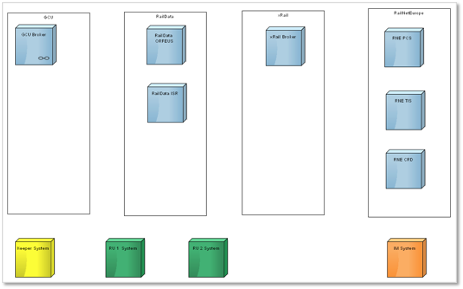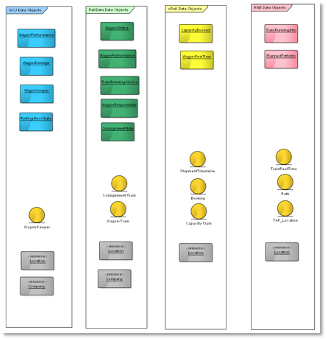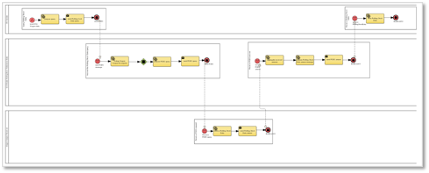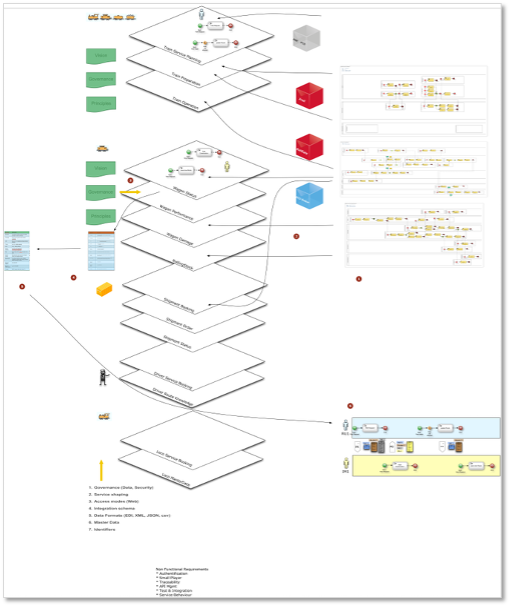Difference between revisions of "Architecture"
(→Perspectives and links to Processes, Objects, Limitations and Capabilities) |
(→Perspectives and links to Processes, Objects, Limitations and Capabilities) |
||
| Line 95: | Line 95: | ||
[[File:Perspective_process_object.png|border|center]] | [[File:Perspective_process_object.png|border|center]] | ||
| − | In the upper area of the perspective you find the <span style="color:#ff0000 | + | In the upper area of the perspective you find the <span style="color:#ff0000; font-weight:bold">Processes</span> that are covered with this perspective. Below the '''Workflows''' for RUs and Partners as well as additional '''Digital Platform Workflows''' are described using swimlanes. |
'''Use cases''' are described in the form of bubbles, showing involved actors. | '''Use cases''' are described in the form of bubbles, showing involved actors. | ||
Revision as of 09:04, 15 February 2021
| under construction |
| this page is still under construction |
Contents
Current Architecture
In a first step existing systems and tools are analysed.
The topology shows the various systems and its current owners.
For those systems the business objects were determined and in a second step the workflows between the business objects.
All information is stored in Enterprise Architect in a common UML Model. A HTML copy of the model can be found here: UML Model
Topology
The topology shows currently existing systems and tools that are analysed in details. The following links guide you to the corresponding architecture models
The main systems are:
The topology can be found here: UML Model - Topology
The following picture shows the platform coverage
Business Objects
The business objects describe in an abstract way the basic objects of todays systems.
They are described in the UML Model for the above mentioned systems
The topology can be found here: UML Model - Business Objects
Detailed Business Objects are available for
Workflows
The workflows describe the interaction of the business objects of todays systems
Each workflow is described with a swimlane diagram in details
Workflow diagrams and swimlanes can be found in the UML model for each of todays systems.
Please refer to the detailed diagrams in the subdirectories of the UML Model - Business Workflows.
Messages and Data Objects
An overview of all messages exchanged with the related data objects in the current architecture landscape can be found as a list in the following document in Teams: [[1]]
Refer to the sheet Messages.
Perspectives
Based on the business objects and workflows of todays systems the services are extracted into abstract layers combining services from various systems.
Steps
The steps (see bullet points) for doing that are:
- Describe the processes and platforms (done in the current architecture)
- Remove platform borders keeping processes and objects
- Analysis of the services based on vision, governance and principles
- Aggregation of the found limitations
- Description of gaps (based on found limitations)
- Align services towards future architecture
Perspectives and links to Processes, Objects, Limitations and Capabilities
Each perspective is assigned to a process and contains the process steps taken out of one of the systems currently covering this perspective. In the UML model the perspectives are described in detail. The following picture shows what can be found for each perspective.
In the upper area of the perspective you find the Processes that are covered with this perspective. Below the Workflows for RUs and Partners as well as additional Digital Platform Workflows are described using swimlanes.
Use cases are described in the form of bubbles, showing involved actors.
Business Objects (blue) and Masterdata (grey) covered by this perspective are described in the lower area of the perspective.
Limitations found in the current perspective are positioned where they occur (activity, business object or below the processes for general limitations) and described with boxes (orange/brown).
Sector Initiatives belonging to this perspective that are not yet covered by a system or not yet described in the UML model are described with arrow-boxes (green).
Limitations are described in detail in a separate document. This document can be found here: List of Limitations.
Todays Perspectives
The following perspectives were identified. The ones that contain a link are already defined and described in the UML Model.
- Train Service Planning
- Train Preparation
- Train Operation
- Wagon Status
- Wagon Performance
- Wagon Damage
- Wagon Check
- Order Consignment
- Braking Rules
- Rolling Stock Dataset
- Shipment Booking
- Shipment Status
Further possible Perspectives
Addtionally the following possible perspectives were identified. These perspectives may be analyzed in a later step.
- Transport Planning and Preparation
- Driver Service Book
- Driver Route Knowledge
- Locomotive Service Book
- Locomotive Master Data
The perspectives can be found in the UML Model
The list of limitations can be found here: List of Limitations






